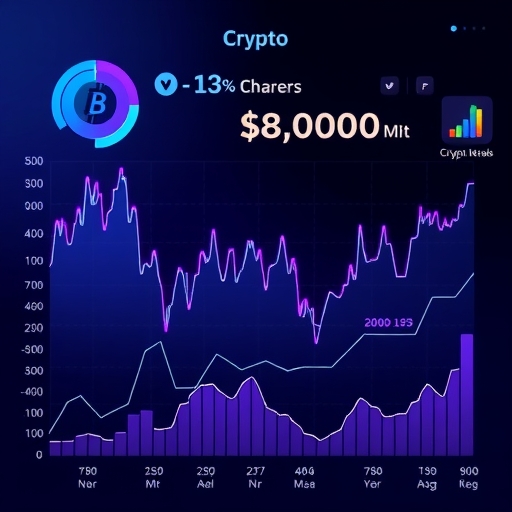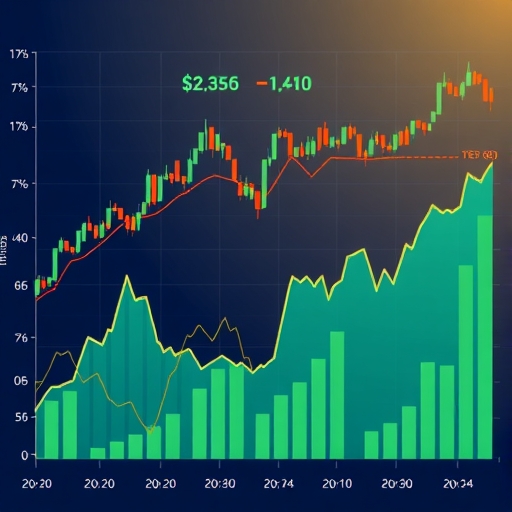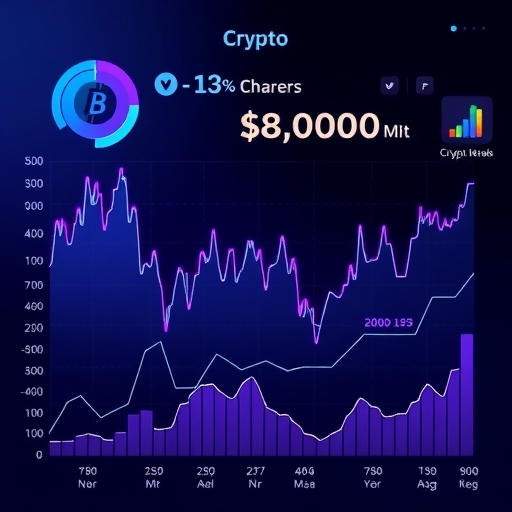Understanding Crypto Leverage Trading: Your Guide to Amplified Potential and Managed Risks
Are you curious about how some cryptocurrency traders seem to make significant gains from relatively small capital? The answer often lies in leverage trading, a powerful but complex strategy that allows you to amplify your market exposure. While the allure of magnified returns is strong, the inherent risks—particularly rapid liquidation in volatile markets—demand a deep understanding of its mechanics and a disciplined approach to risk management. In this comprehensive guide, we will demystify leverage and margin trading, offering insights into how it works, its benefits and pitfalls, best practices for safe engagement, and crucial criteria for selecting the most suitable trading platforms.
The Core Mechanics: Deconstructing Crypto Leverage and Margin
At its heart, cryptocurrency leverage trading is about controlling a larger position in the market with a smaller amount of your own capital. How does this work? You essentially borrow funds from a trading platform or exchange to increase your purchasing power. This borrowed capital is what we call leverage, often expressed as a ratio like 10x, 50x, or even 500x. For example, with 10x leverage, every $100 of your own money allows you to control a $1,000 position in a cryptocurrency like Bitcoin (BTC) or Ethereum (ETH).

Understanding key terms is crucial for navigating the world of leveraged crypto trading effectively. Familiarizing yourself with these definitions will help you grasp the mechanics and risks involved.
- Leverage: The ratio of borrowed capital to your own capital, amplifying trading power.
- Margin: The initial capital or collateral deposited to open and maintain a leveraged position.
- Margin Call: A notification from the exchange to deposit more funds to avoid liquidation.
- Liquidation: The automatic closure of a leveraged position by the exchange when margin falls below a certain level.
- Funding Rate: Periodic payments exchanged between long and short positions in perpetual futures contracts.
Here is a simple table illustrating how different leverage ratios can amplify your position size with the same initial margin.
| Your Capital (Margin) | Leverage Ratio | Total Position Size | Required Price Move for 100% Profit (Approx.) |
|---|---|---|---|
| $100 | 1x (No Leverage) | $100 | 100% |
| $100 | 10x | $1,000 | 10% |
| $100 | 50x | $5,000 | 2% |
| $100 | 100x | $10,000 | 1% |
The initial capital you put down to open and maintain this leveraged position is known as margin. Think of margin as a security deposit or collateral. It acts as a buffer against potential losses. If your trade moves against you, your margin absorbs those losses. When the losses become too significant relative to your margin, you might receive a margin call, which is a request from the exchange for you to deposit more funds to keep your position open. If you fail to add more margin, or if the market moves too quickly, the exchange will automatically close your position—this is called liquidation. Liquidation is designed to prevent you from owing the exchange money beyond your deposited collateral.

It’s important to understand the distinction between leverage trading and margin trading. While often used interchangeably, margin trading is a specific method of achieving leverage, typically involving borrowing funds for spot markets (where you directly buy and sell cryptocurrencies). Leverage trading is a broader concept that encompasses various instruments like derivatives, such as futures contracts and perpetual futures, where leverage is often embedded or synthetically achieved without direct loans. For instance, on platforms like Binance or BTCC, you can trade perpetual futures with high leverage, controlling large positions without owning the underlying asset directly.
Understanding Margin Types: Isolated vs. Cross Margin
When engaging in leveraged crypto trading, you’ll typically encounter two main types of margin accounts:
- Isolated Margin: With isolated margin, the collateral you allocate to a specific trade is “isolated” to that single position. This means that if that particular trade goes south, only the margin assigned to it is at risk of liquidation. Your other funds in the account remain safe. This method is generally considered safer for beginners as it limits potential losses to a predetermined amount per trade.
- Cross Margin: In contrast, cross margin uses your entire account balance as collateral for all open positions. If one trade starts losing money, the system can draw from your available balance across all other trades to prevent its liquidation. While this can help prevent individual liquidations, it also means that your entire account balance is potentially at risk if multiple positions turn against you or if a significant market swing occurs. This type of margin is usually preferred by more experienced traders who have a comprehensive understanding of their overall portfolio risk.
Here is a detailed comparison of isolated margin and cross margin to help you choose the appropriate method for your trading strategy.
| Feature | Isolated Margin | Cross Margin |
|---|---|---|
| Risk Management | Limits risk to individual positions; easier to manage per-trade risk. | Spreads risk across all open positions; higher overall account risk. |
| Liquidation Impact | Only the margin for that specific position is liquidated. | Entire account balance can be used to prevent liquidation, potentially leading to full account liquidation. |
| Flexibility | Less flexible; requires manual addition of margin for specific trades. | More flexible; automatically draws from available balance to maintain positions. |
| Best For | Beginners, high-risk strategies with defined stop-losses, or traders wanting to limit exposure per trade. | Experienced traders with strong risk management, hedging strategies, or those with diversified portfolios. |
Navigating the Double-Edged Sword: Benefits and Risks of Leveraged Trading
Leverage trading in the cryptocurrency market can be incredibly alluring due to its potential for amplified returns. However, it’s crucial to understand that this amplification works both ways, significantly magnifying potential losses as well. Let’s break down the key benefits and inherent risks.
Benefits of Leveraged Crypto Trading:
- Enhanced Exposure: You can gain significantly larger exposure to market movements than your initial capital would normally allow. This means that even small price movements can translate into substantial profits if your trade is successful.
- Greater Potential Returns: The primary appeal of leverage is the ability to multiply your profits. A 1% price increase on a 100x leveraged position can yield a 100% return on your initial margin.
- Capital Efficiency: Leverage allows you to use a smaller amount of your own capital to open a larger position, freeing up the rest of your funds for other investments or purposes.
- Strategy Diversification: It enables various trading strategies, including short-selling (profiting from price declines) and hedging (off-setting potential losses in other investments).
- Ability to Short-Sell: If you believe a cryptocurrency’s price will fall, leverage trading allows you to “short” the asset, borrowing and selling it, then buying it back at a lower price to return the borrowed amount and pocket the difference.
Many traders choose to apply leverage to a select group of highly liquid and volatile cryptocurrencies. These assets typically offer sufficient market depth for larger positions.
- Bitcoin (BTC): The largest cryptocurrency by market cap, offering high liquidity and often setting market trends.
- Ethereum (ETH): The second-largest, with strong ecosystem development and significant trading volume.
- Solana (SOL): Known for its high throughput and growing DeFi and NFT ecosystem, offering significant volatility.
- Ripple (XRP): A cross-border payment focused cryptocurrency, often subject to news-driven price swings.
- Dogecoin (DOGE) / Shiba Inu (SHIB) / Pepe (PEPE) / Bonk (BONK): Popular meme coins known for extreme volatility and community-driven pumps and dumps.
Risks of Leveraged Crypto Trading:
- Magnified Losses: This is the most significant risk. Just as profits are amplified, so are losses. A small adverse price movement can quickly wipe out your entire margin.
- High Liquidation Risk: The closer your position gets to your liquidation price, the higher the chance that the exchange will automatically close your trade to prevent further losses. In highly volatile markets, this can happen very rapidly.
- Do Not Own the Underlying Asset: When you trade futures or perpetual futures with leverage, you do not actually own the cryptocurrency. You are merely speculating on its price movement.
- Rapid Capital Loss: Due to the extreme volatility of digital assets, especially during sudden market swings, an entire account can be liquidated in minutes. This makes it particularly difficult for new traders to navigate.
- Daily Funding Fees: For positions held overnight, particularly in perpetual futures contracts, traders pay or receive daily funding fees. These fees, which adjust based on market demand, can erode profits or accelerate losses over time if you are on the wrong side of the funding rate.
- Counterparty Risk: There’s always a risk associated with the exchange itself, such as hacks, insolvency, or technical outages. Choosing a platform with robust security measures, like BTCC with its long track record of zero hacks, is paramount.
- Systemic Risks: Unexpected events like exchange outages, significant slippage (where your order is filled at a price much worse than expected), or network congestion can severely impact leveraged positions.

As you can see, while the potential for amplified gains is enticing, the magnified risks demand extreme caution and a well-defined risk management strategy. Are you prepared to manage these risks effectively?
Implementing Smart Strategies: Best Practices for Risk Management
Success in cryptocurrency leverage trading hinges not on predicting the future, but on effective risk management. Without it, even a few bad trades can lead to catastrophic losses. Here are essential practices to protect your capital and navigate the volatile world of leveraged crypto.
- Start with Low Leverage (Especially for Beginners): If you are new to leverage, begin with very low ratios, such as 2x to 5x. This allows you to understand the mechanics and market dynamics without exposing yourself to immediate, high-risk liquidation. Gradually increase leverage only as your experience and confidence grow.
- Always Set Stop-Loss Orders: This is arguably the most critical rule. A stop-loss order automatically closes your position when the price reaches a predetermined level, limiting your potential losses. It’s your primary defense against sudden, adverse market moves and helps prevent an entire account wipeout. Never open a leveraged position without setting a stop-loss.
- Monitor Positions Frequently: Due to the rapid market swings common in cryptocurrency, continuous monitoring of your open positions is essential. Be prepared to adjust your strategy or close positions if market conditions change unexpectedly.
- Understand Market Volatility and Fundamentals: Base your decisions on thorough technical analysis and a solid understanding of market fundamentals, rather than emotion or fear of missing out (FOMO). Volatility is a constant in crypto; recognize its patterns and impacts.
- Limit Initial Investment Per Trade: Never put more than a small percentage of your total trading capital into a single leveraged trade. Many experienced traders recommend limiting this to 1-5% of your total portfolio, even less for high-leverage trades.
- Trade with Discipline: Emotional decisions are the enemy of profitable trading. Stick to your trading plan, avoid impulsive actions, and don’t chase losses. Discipline is key to long-term success.
- Evaluate Platform Reliability and Fees: Before committing capital, thoroughly research the trading platform’s security measures, track record, and fee structures. Hidden fees (like daily funding fees on perpetual futures) can significantly impact your profitability.
- Prepare for Adverse Price Moves: Always assume the market can move against you. Have a contingency plan for what you will do if your trade starts losing money. This includes having extra margin available or being ready to close the position.
- Diversify Across Assets: While leveraged trading often focuses on specific assets like BTC or ETH, consider diversifying your overall portfolio to spread risk, even if individual leveraged trades are concentrated.

Beyond the fundamental strategies, successful leveraged trading also requires an understanding of key metrics that influence your positions and overall profitability. These indicators can help you make more informed decisions.
- Liquidation Price: The specific price level at which your position will be automatically closed by the exchange.
- Maintenance Margin: The minimum amount of equity required to keep a position open, typically a percentage of the total position value.
- Realized P&L: The profit or loss from closed positions, reflecting actual gains or losses.
- Unrealized P&L: The current profit or loss of open positions, which fluctuates with market price.
- Initial Margin: The percentage of the total trade value that must be deposited to open a leveraged position.
By diligently applying these risk management practices, you can significantly improve your chances of success and protect your capital in the high-stakes environment of leveraged crypto trading.
Choosing Your Command Center: A Guide to Top Leverage Trading Platforms
Selecting the right cryptocurrency leverage trading platform is a critical decision that impacts your security, trading experience, and potential profitability. With numerous options available, how do you choose? We should consider several key criteria.
Key Selection Criteria for Crypto Leverage Trading Platforms:
- Platform Security: This is paramount. Look for exchanges with robust security measures like Two-Factor Authentication (2FA), cold storage for client funds, regular security audits, and a clean track record free from hacks or major security incidents.
- Leverage Options: Assess the range of available leverage levels. While high leverage like 500x can be tempting, ensure the platform offers options suitable for your risk tolerance (e.g., lower leverage for beginners).
- Trading Fees: Compare competitive and transparent fee structures, including trading fees (maker/taker fees), funding fees for perpetual futures, and withdrawal fees. These costs can significantly impact your net returns.
- Cryptocurrency Support: A wider range of supported cryptocurrencies and trading pairs offers more opportunities. Look for platforms that list major assets like Bitcoin (BTC) and Ethereum (ETH), alongside popular altcoins such as TRX, PEPE, and BONK.
- User Trading Experience: The platform should have a user-friendly interface, fast order execution speed, and high reliability, especially during periods of high market volatility. Features like demo accounts (for practice) and copy trading can also be beneficial.
- Customer Support: Responsive and accessible customer support channels (live chat, email) are crucial for resolving any issues promptly.
Understanding the various factors that influence funding fees is crucial, especially for long-term leveraged positions in perpetual futures, as they can significantly impact your profitability.
| Factor | Description | Impact on Funding Rate |
|---|---|---|
| Market Sentiment | Dominance of long (bullish) or short (bearish) positions. | Positive if more longs, negative if more shorts. |
| Interest Rate Differential | Difference between spot and futures prices. | Higher premium on futures leads to higher funding. |
| Exchange Mechanics | Specific calculation methods and intervals (e.g., every 8 hours). | Varies by platform, affecting frequency and magnitude. |
| Liquidity & Volume | Overall trading activity and depth of order books. | Highly liquid markets tend to have more stable funding rates. |
Let’s compare a few leading platforms known for their leverage trading offerings:
| Platform | Key Features & Leverage | Pros | Cons/Considerations |
|---|---|---|---|
| BTCC | Up to 500x leverage, established since 2011, low fees (0.06% maker/taker futures), copy trading, demo account. | Long operational history (zero hacks), high leverage options, regulated in US, Canada, Europe. Excellent for experienced traders. | May seem complex for absolute beginners due to high leverage options. |
| Binance | Up to 125x leverage (BTC futures), 400+ cryptocurrencies, high trading volume, competitive fees (0.02%/0.05% futures). | High liquidity, vast selection of assets, advanced trading tools. | Can be overwhelming for new traders, faces regulatory scrutiny in some regions. |
| MEXC | Up to 200x leverage, 2500+ cryptocurrencies, zero-fee for futures maker, no KYC for basic accounts (up to 10 BTC/day withdrawal). | Extremely wide range of altcoins, very low futures fees, privacy-friendly. | No margin trading or options, potentially less suited for very high volume institutional traders compared to Binance. |
| Margex | Up to 100x leverage, robust risk controls, user-friendly, fair pricing, no KYC needed for instant trading. | Focus on risk management tools, beginner-friendly interface, strong security. | Fewer supported assets compared to larger exchanges. |
| Kraken | Offers margin trading (limited to 5x in US for Eligible Contract Participants), regulated. | Strong regulatory compliance, good security, reputable. | Lower leverage options, especially for US retail users. |
| Coinbase Derivatives | US-regulated platform for futures contracts, CFTC-compliant. | High regulatory compliance in the US. | Limited access to specific users (ECPs), potentially higher barrier to entry for retail. |
When making your choice, prioritize platforms like BTCC that combine a long-standing reputation for security with the leverage options and features that match your trading style and experience level.
Regulatory Landscape and Future Outlook for Leveraged Crypto
The regulatory environment surrounding cryptocurrency leverage trading is constantly evolving, particularly in major financial jurisdictions like the United States. Understanding these regulations is crucial for ensuring you operate within legal boundaries and avoid potential risks.
In the US, for example, spot margin trading is heavily restricted for retail users. Access is generally limited to “Eligible Contract Participants” (ECPs), who typically need to meet high asset thresholds. This means that many US-based retail traders cannot directly engage in high-leverage spot trading on most platforms.
However, futures trading is permitted under the oversight of the Commodity Futures Trading Commission (CFTC). For an exchange to offer crypto futures contracts to US customers, it must be registered as a Derivatives Clearing Organization (DCO) or a Designated Contract Market (DCM). This regulatory framework aims to provide a more structured and secure environment for derivatives trading, contrasting with the often less regulated spot markets.
Platforms like Coinbase Derivatives operate under this CFTC compliance, offering regulated futures contracts to eligible participants. This emphasis on compliance underscores the importance of using regulated platforms to avoid legal and financial risks, including potential issues with fund recovery or unexpected regulatory crackdowns.
The future outlook for leveraged crypto suggests a continued push for greater regulatory clarity and oversight. As the market matures, we can expect more defined rules that aim to protect investors while fostering innovation. This evolving landscape means traders must remain vigilant, always opting for platforms that demonstrate strong regulatory adherence and a commitment to user security. The global nature of cryptocurrency also means that regulations vary significantly by country, with some regions like Canada and Europe also developing specific frameworks for leveraged products.
Conclusion: Mastering the Art of Leveraged Crypto
In conclusion, cryptocurrency leverage trading presents a potent opportunity for experienced investors to amplify their returns with judicious capital deployment. However, its inherent volatility and the potential for rapid losses necessitate an unwavering commitment to risk management. This includes disciplined leverage usage, strategic stop-loss implementation, and continuous market vigilance. Choosing a reputable, secure, and well-regulated trading platform, like those with a proven track record of security and compliance, is equally vital.
For beginners, a cautious approach with minimal leverage (e.g., 2x-5x) is strongly advised. Focus on building a foundational understanding of market dynamics and the operational mechanics before venturing into higher-risk strategies. Ultimately, success in leveraged crypto trading hinges on a blend of informed decision-making, robust risk controls, and a realistic appraisal of market forces. Remember, while the potential rewards are significant, the risks are equally magnified. Trade wisely.
Disclaimer: This article is for informational and educational purposes only and should not be construed as financial advice. Cryptocurrency trading, especially with leverage, carries significant risks, including the total loss of capital. Always conduct your own research and consult with a qualified financial professional before making any investment decisions.
Frequently Asked Questions (FAQ)
Q: What is the primary difference between isolated margin and cross margin?
A: Isolated margin dedicates a specific amount of collateral to a single position, limiting the potential loss to that amount. Cross margin, conversely, uses your entire available balance as collateral for all open positions, meaning a losing trade can draw from funds allocated to other trades, potentially increasing overall account risk.
Q: How does leverage amplify both profits and losses?
A: Leverage allows you to control a larger position with a smaller amount of your own capital. If the market moves in your favor, the percentage gain on the larger position translates to a magnified profit relative to your initial margin. However, if the market moves against you, the percentage loss on the larger position is also magnified, quickly eroding your initial margin and potentially leading to liquidation.
Q: Why is setting a stop-loss order considered a best practice in leveraged trading?
A: Setting a stop-loss order is crucial because it automatically closes your position when the price reaches a predetermined level, effectively limiting your potential losses. In highly volatile cryptocurrency markets, a sudden adverse price movement can quickly wipe out your entire margin. A stop-loss acts as a vital risk management tool to prevent catastrophic losses and protect your capital.



No responses yet